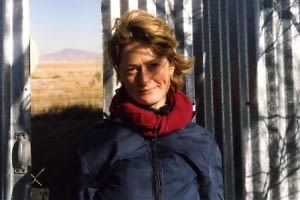Slide #2
 Are the spaces similar to each other in any way?
What I've noticed really about all of our spaces is how there's texture and warmth in all of them. In Texas you have huge hangar rooms that have adobe as the wall and then they have concrete floors, but they're not brand new. You're surrounded by wood and adobe and a lot of light and then in other rooms there’s like this beautiful natural plaster that's very soft and texture and the same plaster is actually on the walls at Spring Street. And even at Spring Street, you have all this wood on different floors and some ceiling but these environments just have what the Japanese call wabi-sabi, a kind of warm thing to them. I feel like our culture tries to grapple with what to save, and what to destroy. The culture has an impulse towards making everything cold and non-descript, and it's very ironic that my Dad's work is referred to as minimalist, because he isn't somebody who created a lot of very cold spaces, but some of his work that was machine made, specifically the pieces that were made in Switzerland, he would take them and put them in really warm environments. And then a museum buys them and puts them in a cold environment, and you look at the piece and you're not even conscious that you're experiencing cold on cold and it's not working as well. This is my humble opinion...that once you see this beautiful sleek piece, which is made in Switzerland, you know that in a much warmer environment it has this kind of "pop" to it, and you feel like you can appreciate both.
So, Spring Street and the 15 buildings in Marfa, are those housing your father’s art right now?
There is one building that's the old bank of Marfa, (someone went and built an old tacky bank down the street), that for example, has some of his furniture and some of his art, but it's extremely integrated with beautiful French pieces of furniture. It's his version of a design museum. All these beautiful design things he loved. It's basically him creating spaces and environments so that he could look at things that he really appreciated and collected. So not everything is really just about creating spaces to see his art. There is his art in it, but it's also about creating spaces for him to work in. Like his studio, which is in an old supermarket building that he bought and that was really functional. So whatever was up when he passed away is really what we have there. Those aren't necessarily set as what people should look at. It was more of a private studio space for him.
[Photo by Martin Donovan]
Are the spaces similar to each other in any way?
What I've noticed really about all of our spaces is how there's texture and warmth in all of them. In Texas you have huge hangar rooms that have adobe as the wall and then they have concrete floors, but they're not brand new. You're surrounded by wood and adobe and a lot of light and then in other rooms there’s like this beautiful natural plaster that's very soft and texture and the same plaster is actually on the walls at Spring Street. And even at Spring Street, you have all this wood on different floors and some ceiling but these environments just have what the Japanese call wabi-sabi, a kind of warm thing to them. I feel like our culture tries to grapple with what to save, and what to destroy. The culture has an impulse towards making everything cold and non-descript, and it's very ironic that my Dad's work is referred to as minimalist, because he isn't somebody who created a lot of very cold spaces, but some of his work that was machine made, specifically the pieces that were made in Switzerland, he would take them and put them in really warm environments. And then a museum buys them and puts them in a cold environment, and you look at the piece and you're not even conscious that you're experiencing cold on cold and it's not working as well. This is my humble opinion...that once you see this beautiful sleek piece, which is made in Switzerland, you know that in a much warmer environment it has this kind of "pop" to it, and you feel like you can appreciate both.
So, Spring Street and the 15 buildings in Marfa, are those housing your father’s art right now?
There is one building that's the old bank of Marfa, (someone went and built an old tacky bank down the street), that for example, has some of his furniture and some of his art, but it's extremely integrated with beautiful French pieces of furniture. It's his version of a design museum. All these beautiful design things he loved. It's basically him creating spaces and environments so that he could look at things that he really appreciated and collected. So not everything is really just about creating spaces to see his art. There is his art in it, but it's also about creating spaces for him to work in. Like his studio, which is in an old supermarket building that he bought and that was really functional. So whatever was up when he passed away is really what we have there. Those aren't necessarily set as what people should look at. It was more of a private studio space for him.
[Photo by Martin Donovan]

.jpg)
.jpg)



.jpg)
.jpg)
.jpg)




.jpg)